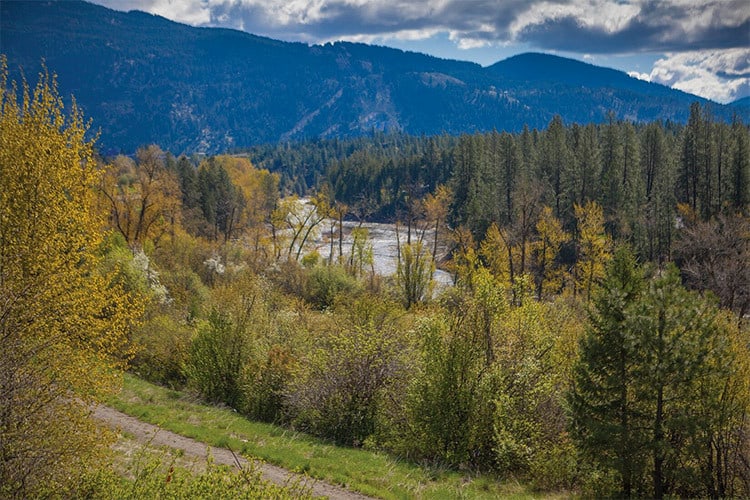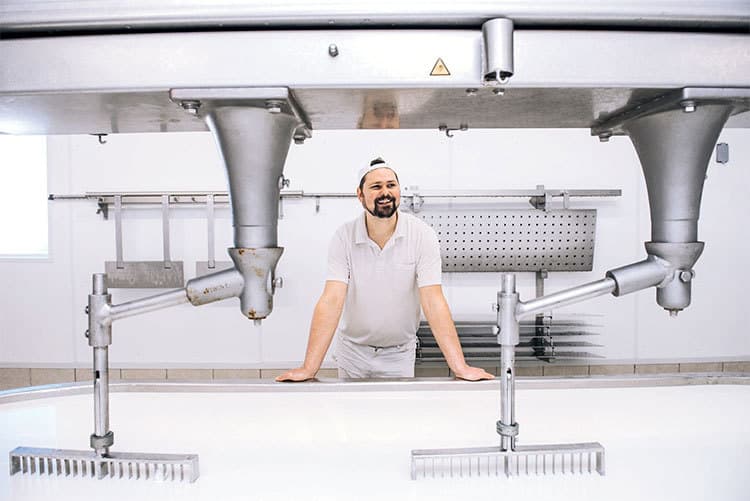
In some places, history oozes down streets like a ripe brie. Cobblestones tell stories, ruins reveal hardships and happenstance, and memorials speak of wars fought and blood spilled.
But in British Columbia’s Okanagan Valley, a half-day’s drive (or 45-minute flight) from Vancouver, the food scene is fresh and young—and it stars cheese and wine. It also relies heavily on migrants bringing talents and traditions from far-flung lands: a maker recreating cheeses from his Swiss-Italian Alps boyhood, a Dutch family replicating a long-gone grandmother’s Gouda, a young woman driving cross-country with five cats to find her passion as a cheesemaker’s apprentice.
Like the mavericks who transformed the Okanagan from a wine world start-up into one of the world’s top 10 vino destinations, cheesemakers here have ambition in spades. And since being in a young industry in a young land means there are no rules, no traditions, and no expectations, ambition is exactly what it takes to succeed.

Ripe for Picking
An area that was largely unsettled until the 1880s, much of the Okanagan’s population has arrived in the last three decades. Today it’s among Canada’s fastest-growing regions, its newcomers arriving with dreams of what’s possible in a new land.
And land is the star of the Okanagan’s story, thanks to unique geology created during the Ice Age, when a mile-thick glacier carved out Okanagan Lake. Along the way, it deposited mineral-rich sands and soils ideal for the apples and grapes that make this Canada’s food basket, home to the country’s earliest-ripening fruit.
The Okanagan is also blessed with one of Canada’s warmest climates. Visitors are often shocked to see its dusty mountains, sandy vineyards, tumbleweeds, ponderosa pines, cacti, and even rattlesnakes. In Canada? In Canada! After all, the Okanagan slinks down into the United States’ Great Desert Basin—with hot summers and sunny powder-snow winters, outdoor activities are year-round here. The Kettle Valley Railway has over 350 miles of mountainous bike trails. There’s golf, parasailing, skiing and snowboarding at Apex and Big White resorts, plus hiking and horseback riding. In the Okanagan, connecting with nature is unavoidable.
A New Life
The mix of agriculture and outdoor life is what summoned Igor and Irma Ruffa of Bella Stella Cheese, who sought a simple country setting for their young family to farm. The Alpine meadows, rich grasslands, and northern sun of the Okanagan reminded Igor of his boyhood in Switzerland.
The Ruffas had begun making cheese in the Alps but realized they’d never be able to afford the operation they dreamed of there—in Canada, though, it was possible. They emigrated in 2011 and settled in Lumby, a tiny town in the Monashee Mountains. With a population of 1,700, the hamlet is off the beaten path, allowing Igor to work free from distraction.
The Ruffas make farmers’ market rounds a couple of times a week. I meet Igor on a hot September morning in his small booth at the market in Kelowna. We speak of his quest to locate the highest-quality organic milk; he says he’s found it down the road at a dairy in Lumby. Our conversation is interrupted when a family approaches and begins chatting in Italian. They soon leave with several wheels of Bella Stella Formaggella, a washed-rind disk that they tell me reminds them of home.
Igor is a quiet, unassuming man who believes that cheese is alive and sensitive to the seasons, sun, grass, and more. His constant pursuit to better his product is driven by warm memories of Alpine meadows, cheeses made by his grandmother, and a life less complicated.
Monashee Gold is born of that nostalgia. It’s a firm cheese that’s sweet, salty, buttery, and rich. Made with Jersey cow’s milk, it’s the closest Igor may ever get to his fabled childhood Swiss cheese, due to terroir differences. After all, there are no edelweiss flowers for cattle to nibble in Lumby’s White Valley, half a world away.
 Bella Stella cheeses rest on racks
Bella Stella cheeses rest on racks
The Gouda Life
European immigrants are just as fond of Triple Island Farm, run by Helma and Johan Tuitjel and their family in Cherryville, just 11 miles from Bella Stella. In 2001, the family left the Netherlands for Canada on a dairy farm work permit and fell in love with the region. By 2005, they had purchased a cattle ranch in Cherryville. They worked as beef producers before switching to dairy, and began cheese production in 2008 with 12 cows. Today, Canadian law requires a minimum aging period of two months for unpasteurized wheels, which means that Triple Island’s “mild” Gouda is more like Europe’s “medium.” They also offer medium, medium-extra, and aged versions, which they sell at local farmers’ markets.
I brave the Gouda-seeking crowds to chat with the couple. Helma excuses herself when an older German woman approaches, and quickly fetches two large bags with over $200 worth of cheese for her. They chat briefly, lamenting tourist traffic and gas prices while money changes hands.
I ask the woman if she is buying for a deli or restaurant. No, she replies—she drove over 100 miles just to buy Triple Island cheese, a trip she makes three or four times a year. Their gouda, she tells me, is the only one that’s reminiscent of the Bavarian cheeses of her youth. It’s worth the journey—and far cheaper than even the mass-produced versions.
With no middlemen, no retail sales, and no need to advertise, the Tuitjels sell their product for a song. In fact, the cheese is so sought-after regionally that Triple Island still lacks a strong web presence. Their main promotional strategy is a pamphlet in the market booth explaining the creamery’s business ethos.
By the time the market closes, the Triple Island display is almost empty, their Maasdammer and vast range of Goudas—including ones flavored with stinging nettle, cumin, and chives—in the hands of happy customers.
 Kees Tuijtel (Johan’s son) of Triple Island Farm
Kees Tuijtel (Johan’s son) of Triple Island Farm
Gone West
Not all Okanagan newcomers come from the Old World. Shana Miller, cheesemaker at Upper Bench Winery & Creamery, packed her life (and her five cats) into her car and drove over 3,500 miles from eastern Quebec to settle in Penticton, in the South Okanagan. She sought adventure and a job, but little did she know that joining Poplar Grove Winery’s cheese operation 14 years ago would set her career—and life—on an all-consuming path. Around the same time that Poplar Grove hired Shana as cheesemaker’s assistant, they hired Englishman Gavin Miller to make wine. Shana and Gavin soon fell in love and married, and when Poplar Grove’s owners divorced, Shana and Gavin went their own way, founding Upper Bench.
Shana may just be the region’s biggest cheese nerd. She pores over 19th-century cheesemaking books and is so detail-oriented that once, when watching a documentary on Stilton, she zoomed into the footage and watched frame by frame to study factory settings for humidity and temperature.
She boasts that her greatest cheese compliment came when some Quebeckers ate her Upper Bench Gold and said it was how Oka—a Quebecois washed-rind cheese with Trappist origins—used to taste. Her U&Brie has an unexpectedly mild rind, rendering it as delicate as it is rich. And Upper Bench’s biggest seller, King Cole Blue, is a soft, gooey wheel that can turn blue cheese haters into lovers.
Despite a successful line that often sells out before new batches can be shelved, Shana is a mad scientist in her lab, ever tinkering with new products. Her latest project is a lactic acid cheese similar to Valençay—a tart, gooey mess that gushes when cut. She shows me a specialty blue infused with cacao nibs, which she’s masterminding for Upper Bench’s Curds & Corks Club.
Despite the 2007 split from its namesake winery, Poplar Grove Cheese (Shana’s former stomping grounds) still thrives under original owner Gitta Pedersen. Its tried and true line—Naramata Bench Blue, Tiger Blue, Harvest Moon Washed Rind, and Okanagan Double-Cream Camembert—has a big following. Head cheesemaker Louise Pearson has her hands full, as the company now ships its small-batch cheeses coast to coast.
Making History
The lasting connection between Poplar Grove and Upper Bench epitomizes the Okanagan’s uniqueness as a food region. Despite becoming “competition” over the years, the makers remain close friends. From wineries to restaurants to farmers’ market stalls, everyone raves about the talents of someone else. “Being supported by industry peers who you know on a first-name basis—this camaraderie can be felt by all of us,” says Pearson. Shana Miller agrees: “We sincerely appreciate the support of those around us, working alongside us and encouraging us to succeed in our little piece of paradise here in Penticton,” she says.
Perhaps nobody sums up the Okanagan’s current food zeitgeist better than Jennifer Schell, author of The Butcher, The Baker, The Wine & Cheese Maker in the Okanagan (TouchWood Editions, 2016), an award-winning book about the local food community.
“Because this region is so new, [cheesemakers] can be like cheese cowboys and cowgirls and go wild with experimenting,” Schell says. “We are attracting world-class artisans and winemakers who want to become part of the history we are now creating.”
With the population increasing on average by eight percent yearly, the food scene in this sunny artisanal outpost is bound to keep evolving. There may not be much cheese history in the Okanagan, but it’s got a whole lot of future.
Photographed by Paulina O. Niechcial




